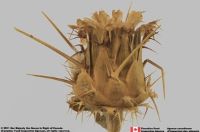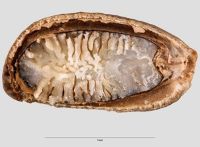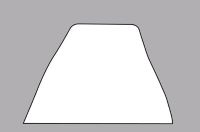Content is from Kirkbride et al. 2006Kirkbride et al. 2006:
Kirkbride JH, Jr, Gunn CR, and Dallwitz MJ. 2006. Family guide for fruits and seeds, vers. 1.0. Accessed September 2020-January 2022. URL: https://nt.ars-grin.gov/seedsfruits/keys/frsdfam/index.cfm ., without modification.
Updates are forthcoming.
 , Cryptothlada, Morina).
, Cryptothlada, Morina).Fruits: Pistil(s) 1; 1-pistillate. Fruit anthocarpanthocarp:
simple or compound and including some tissue of non-ovarian origin (accessory tissue) ; simple; cypselacypsela:
; simple; cypselacypsela:
dry, indehiscent, unilocular fruit with a single seed not adnate to the pericarp, similar to an achene but developed from an inferior ovary. Fruit type of Asteraceae. (based on Dipsacaceae); without persistent central column; within accessory organ(s), or not within accessory organ(s); within involucreinvolucre:
(based on Dipsacaceae); without persistent central column; within accessory organ(s), or not within accessory organ(s); within involucreinvolucre:
in the grasses, a whorl or cluster of bracts or bristles subtending a floret or spikelet (including 5 long awned calyxcalyx:
(including 5 long awned calyxcalyx:
the outer whorl of the perianth; all the sepals of a flower lobes), or calyxcalyx:
lobes), or calyxcalyx:
the outer whorl of the perianth; all the sepals of a flower ; accrescentaccrescent:
; accrescentaccrescent:
growing continuously
; persistent; soft calyxcalyx:
the outer whorl of the perianth; all the sepals of a flower , or hard calyxcalyx:
, or hard calyxcalyx:
the outer whorl of the perianth; all the sepals of a flower (possibly); 1-seeded; 1-seeded; with 1-carpellate; in transection tereteterete:
(possibly); 1-seeded; 1-seeded; with 1-carpellate; in transection tereteterete:
approximately circular in cross section; width and thickness approximately equal
 ; apexapex:
; apexapex:
the point farthest from the point of attachment, or the "tip" of an organ not beaked; indehiscentindehiscent:
not beaked; indehiscentindehiscent:
not opening on its own, as in a fruit
 . Epicarpepicarp:
. Epicarpepicarp:
outer layer of fruit wall or pericarp, if divided into layers; note here used synonymously with exocarp brown (all shades) (at least); durable; glabrousglabrous:
brown (all shades) (at least); durable; glabrousglabrous:
without hairs
; without armature; smooth, or not smooth; rugoserugose:
wrinkled ; without wing(s); without apicalapical:
; without wing(s); without apicalapical:
at or pertaining to the end of the seed or fruit distal from its point of attachment (i.e., base)
respiratory hole. Mesocarpmesocarp:
the middle layer of the pericarp, if divided into layers absent. Endocarpendocarp:
absent. Endocarpendocarp:
the inner layer of the pericarp, if divided into layers present; not separating from exocarpexocarp:
present; not separating from exocarpexocarp:
outer layer of fruit wall or pericarp, if divided into layers; note here used synonymously with epicarp ; thin; not splitting into 1-seeded pyrenes; without operculumoperculum:
; thin; not splitting into 1-seeded pyrenes; without operculumoperculum:
a dehiscent cap (or lid) of a seed or fruit that opens during germination or dehiscence ; without secretory cavities; without longitudinallongitudinal:
; without secretory cavities; without longitudinallongitudinal:
of or relating to length or the lengthwise dimension
ridges. Funiculusfuniculus:
(alt. funicle) stalk connecting the ovule (later seed) to the ovary (later fruit) placenta short; short without seed bearing hookswith hooks:
short; short without seed bearing hookswith hooks:
bristles or spines with curved or backwards pointing tips, or with secondary bristles along their length (retinacula); not persisting in fruit after seed shed.
(retinacula); not persisting in fruit after seed shed.
Seeds: Arilaril:
(broad sense) appendicular structure that wholly or partly envelops a seed and is produced from or a modification of the funicle, raphe, or outer integument; usually fleshy or pulpy, sometimes spongy or tufted-capillate, often brightly colored absent. Seed straight; in transection tereteterete:
absent. Seed straight; in transection tereteterete:
approximately circular in cross section; width and thickness approximately equal
 ; not bowl shaped; not nutlike; without winglike beakbeak:
; not bowl shaped; not nutlike; without winglike beakbeak:
a usually firm, terminal appendage, sometimes tapered ; without caudatecaudate:
; without caudatecaudate:
tapering to a long, tail-like appendage appendage(s); at maturity with food reserves; with endosperm; without canavanine. Sarcotestasarcotesta:
appendage(s); at maturity with food reserves; with endosperm; without canavanine. Sarcotestasarcotesta:
pulpy or fleshy outer layer of the seed coat, simulates aril absent. Testatesta:
absent. Testatesta:
seed coat
 present (but hardly separable from pericarppericarp:
present (but hardly separable from pericarppericarp:
fruit wall or fruit coat
); without markedly different marginalmarginal:
at, on, or close to the margin or border
tissue; without fleshy or leatheryleathery:
texture—moderately thick, tough, and very pliable
layer over hard layer; tight; without crease or line separating cotyledons from hypocotyl-radicle; without notch along margin where cotyledons from hypocotyl-radicle tip approach each other; without glands; without bristles; glabrousglabrous:
without hairs
; without wings; without collar; without operculumoperculum:
a dehiscent cap (or lid) of a seed or fruit that opens during germination or dehiscence ; colored; monochrome; membranousmembranous:
; colored; monochrome; membranousmembranous:
texture—extremely thin, pliable, and fairly tough
; not becoming mucilaginousmucilaginous:
resembling mucilage; moist and sticky
when wetted; surrounding food reserve. Endosperm scant; opaqueopaque:
not transmitting light
; smooth, or ruminateruminate:
testa or seed coat folded into the endosperm ; without starch; with oils; without fatty acid containing cyclopropene; without apicalapical:
; without starch; with oils; without fatty acid containing cyclopropene; without apicalapical:
at or pertaining to the end of the seed or fruit distal from its point of attachment (i.e., base)
lobes; without chlorophyll; without isodiametric faceted surface; without odor. Embryo differentiated from food reserve; well developed; 1 per seed; partially filling testatesta:
seed coat
 (with food reserve), or nearly filling testatesta:
(with food reserve), or nearly filling testatesta:
seed coat
 (trace or scanty food reserve); Morina (0.3–)0.9 times the length of food reserve; at one end of seed not extending into a depression or cup; basalbasal:
(trace or scanty food reserve); Morina (0.3–)0.9 times the length of food reserve; at one end of seed not extending into a depression or cup; basalbasal:
at or pertaining to the point of attachment; (of embryo) embryo occupies one end of the seed
; foliatefoliate:
appearing leaf-like
; with spatulatespatulate:
2D shape—like a spatula; rounded at the apex, with base long and tapered; (of embryo) embryo is straight and axile and centric with the cotyledons expanded to form the shape of a spatula or spoon; (of cotyledons) cotyledons expanded and wider than the stalk but not invested into the stalk cotyledons; straight; parallel to seed length; embedded in endosperm; with cotyledons gradually connected to hypocotyl-radicle; without coleorhiza; without simmondsin; without stomata; not green; with 2 or more cotyledons. Cotyledons 2; moderately developed, or well developed; 0.35–0.9 times length of embryo; somewhat to significantly wider than hypocotyl-radicle; 1.7–4 times wider than hypocotyl-radicle; not concealing hypocotyl-radicle; not foliaceous; thin; flat; smooth; with apicesapex:
cotyledons; straight; parallel to seed length; embedded in endosperm; with cotyledons gradually connected to hypocotyl-radicle; without coleorhiza; without simmondsin; without stomata; not green; with 2 or more cotyledons. Cotyledons 2; moderately developed, or well developed; 0.35–0.9 times length of embryo; somewhat to significantly wider than hypocotyl-radicle; 1.7–4 times wider than hypocotyl-radicle; not concealing hypocotyl-radicle; not foliaceous; thin; flat; smooth; with apicesapex:
the point farthest from the point of attachment, or the "tip" of an organ entire; with margins separate; basally entire; equal in size; not punctatepunctate:
entire; with margins separate; basally entire; equal in size; not punctatepunctate:
surface relief—dotted with pits or with translucent, sunken glands or with colored dots, similar to pitted dotted. Hypocotyl-radicle small to well developed; straight; not thickened.
dotted. Hypocotyl-radicle small to well developed; straight; not thickened.
Cannon & Cannon (1984) "Fruit dry, indehiscentindehiscent:
not opening on its own, as in a fruit
 , enclosed in the involucel and surmounted by the persistent calyxcalyx:
, enclosed in the involucel and surmounted by the persistent calyxcalyx:
the outer whorl of the perianth; all the sepals of a flower ". "Acantho calyxcalyx:
". "Acantho calyxcalyx:
the outer whorl of the perianth; all the sepals of a flower achenesachene:
achenesachene:
a dry, indehiscent, one-seeded fruit, with seed attached to pericarp at a single point, derived from a single, superior, simple or compound, one-loculed ovary smooth to rugoserugose:
smooth to rugoserugose:
wrinkled , apexapex:
, apexapex:
the point farthest from the point of attachment, or the "tip" of an organ somewhat cupshaped". "Cryptothlada achenesachene:
somewhat cupshaped". "Cryptothlada achenesachene:
a dry, indehiscent, one-seeded fruit, with seed attached to pericarp at a single point, derived from a single, superior, simple or compound, one-loculed ovary rugose, with obliquely truncatetruncate:
rugose, with obliquely truncatetruncate:
terminating abruptly, as if cut straight across apexapex:
apexapex:
the point farthest from the point of attachment, or the "tip" of an organ ". "Morina achenesachene:
". "Morina achenesachene:
a dry, indehiscent, one-seeded fruit, with seed attached to pericarp at a single point, derived from a single, superior, simple or compound, one-loculed ovary rugose, somewhat or markedly truncatetruncate:
rugose, somewhat or markedly truncatetruncate:
terminating abruptly, as if cut straight across ".
".
Literature specific to this family: Cannon, M.J. & J.F.M. Cannon. 1984. A revision of the Morinaceae (Magnoliophyta - Dipsacales). Bull. Brit. Mus. (Nat. Hist.) Bot. 12:1–35; Iranshahr, M. 1978. Morinaceae. In: K.H. Rechinger, ed., Flora des Iranischen hochlandes und der umrahmendsen gebirge, no. 135, pp 1–4, tab. 1–4. Druck & Verlagsanstalt, Graz.
General references: Mabberley, D.J. 1987. The plant-book, 706 p. Cambridge University Press, Cambridge.